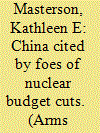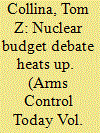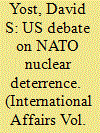| Srl | Item |
| 1 |
ID:
108824


|
|
|
|
|
| Publication |
2011.
|
| Summary/Abstract |
Congress should reconsider proposed cuts to U.S. nuclear weapons spending in light of uncertainties about China's nuclear weapons program, some lawmakers and security analysts are arguing.
Other analysts, however, have said there is little evidence to support some of the more threatening scenarios.
|
|
|
|
|
|
|
|
|
|
|
|
|
|
|
|
| 2 |
ID:
111981


|
|
|
| 3 |
ID:
108635


|
|
|
|
|
| Publication |
2011.
|
| Summary/Abstract |
As the congressional "super committee" prepares its recommendations for reducing the federal deficit by at least $1.2 trillion over 10 years, Congress is beginning to grapple with the question of how much, if at all, to reduce spending on U.S. nuclear weapons.
|
|
|
|
|
|
|
|
|
|
|
|
|
|
|
|
| 4 |
ID:
115585


|
|
|
| 5 |
ID:
115809


|
|
|
| 6 |
ID:
108415


|
|
|
|
|
| Publication |
2011.
|
| Summary/Abstract |
NATO's nuclear deterrence posture has since the late 1950s involved risk-and responsibility-sharing arrangements based on the presence of US nuclear weapons in Europe. Since 1991 gravity bombs, deliverable by US and allied dual-capable aircraft, have been the only type of US nuclear weapons left in Europe. Although many other factors are involved in the alliance's deterrence posture and in US extended deterrence-including intercontinental forces, missile defences, non-nuclear capabilities and declaratory policy-recent discussions in the United States about NATO nuclear deterrence have focused on the future of the remaining US nuclear weapons in Europe. The traditional view has supported long-standing US and NATO policy in holding that the risk- and responsibility-sharing arrangements based on US nuclear weapons in Europe contribute to deterrence and war prevention; provide assurance to the allies of the genuineness of US commitments; and make the extended deterrence responsibility more acceptable to the United States. From this perspective, no further cuts in the US nuclear weapons presence in Europe should be made without an agreement with Russia providing for reductions that address the US-Russian numerical disparity in non-strategic nuclear forces, with reciprocal transparency and verification measures. In contrast, four schools of thought call for withdrawing the remaining US nuclear weapons in Europe without any negotiated Russian reciprocity: some military officers who consider the weapons and associated arrangements unnecessary for deterrence; proponents of ambitious arms control measures who accept extended deterrence policies but view the US weapons in Europe as an obstacle to progress in disarmament; nuclear disarmament champions who reject extended nuclear deterrence policies and who wish to eliminate all nuclear arms promptly; and selective engagement campaigners who want the United States to abandon extended nuclear deterrence commitments to allies on the grounds that they could lead to US involvement in a nuclear war.
|
|
|
|
|
|
|
|
|
|
|
|
|
|
|
|